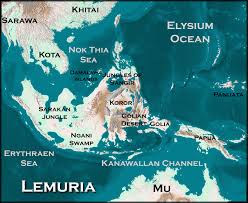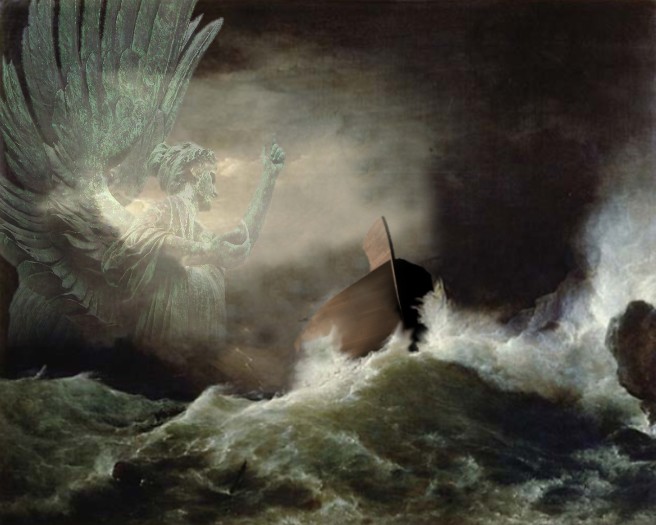Great eruption of Mount Tambora in April 1815 not only crushed and devastated three small kingdoms in the island of Sumbawa. Moreover, far away in Europe, precisely in the Belgian army under the command of the ruler of France, General Napoleon Bonaparte must bend the knees at the hands of England and Prussia.
Yes, three days after the devastating eruption of Tambora, on June 18, 1815, Napolean trapped enemy forces. Because, on the day the weather deteriorated. Continuous rainfall region. In fact, the French army to fight the battle it was.
Due to bad weather, cannon wheels tractor stuck in mud. All vehicles can not go smoothly. The ground was slippery, covered with snow. Understandably, a thick ash from the eruption of Mount Tambora still scattered in the atmosphere to block out the sunlight that falls to earth.
The war was a tragic story of Waterloo for Napoleon. The greatness of Napoleon in subduing his enemies over. He also surrendered.
The general was then exiled to the island of Saint Helena, a small island in the southern Atlantic Ocean. On a remote island that he spent his time until his death in 1821 due to attack cancer.
Kenneth Spink, a geologists theorized, that inclement weather caused by the eruption of Mount Tambora became one of Napoleon's defeat triggers. At a scientific meeting on Applied Geosciences in Warwick, England (1996), Spink said that the eruption of Mount Tambora had a great impact on the order of the world's climate at that time, including bad weather at Waterloo in June 1815.
In Yogyakarta, the eruption of Tambora surprise Thomas Stamford Raffles. Governor-General of the United Kingdom in Java, which came to power in 1811-1816 it was thought that the explosion was coming from enemy cannon fire sound. Naturally so, because when that communication technologies (telegraph) was not created so the eruption could not be delivered to various parts of the area in a relatively fast.
Fear of the enemy attacked, Raffles was then sent troops to guard posts along the coast to be alert. The boats were alerted. What can make, Raffles false allegations. There was no enemy attack.
Mount Tambora
When the summit of Mount Tambora reached a height of about 4,300 meters above sea level (asl). Compare with the highest land in Indonesia, namely Puncak Jayawijaya, Papua, the altitude about 3050 m above sea level.
After the great eruption of Tambora, the land at the top of it spewed out in all directions. As a result, the height of a volcano that was left by half, which is about 2851 m above sea level.
The eruption is so horrible it also left a huge caldera. In fact, according to records, the size of the caldera is most widespread in Indonesia. Imagine, the caldera has a diameter of about 7 km, a maximum length of 16 km and a depth of 1.5 km.
Today, the volcano which is administratively located in two counties; Dompu and Bima, West Nusa Tenggara province (NTB) were left miraculous story, not only in Indonesia but also impacts to the various parts of the world.
Very tense
The tragedy began in early April 1815. When the area around Mount Tambora began to vibrate. Vibration was intensified on 10 April 1815, at 19:00 local time. Since then up to five days, the explosion of Mount Tambora reached its climax.
At night, from a distance Tambora really lit a fire that continues to radiate because of the mountain peaks. The atmosphere was very tense. Mountain stream seemed to turn into a huge fire.
At the same time, the eruption was also spewing hot gas, ash, and rocks toward the bottom as far as 20 km down to the sea. Villages around Tambora was destroyed by pyroclastic flows engulfed them.
According to Firdaus Haris in his book titled Greatest Mysteries of Indonesia (2008), three small kingdoms burned and destroyed by the lava and the eruption of Mount Tambora material. The third kingdom is Concentrated within about 30 miles west of Tambora. Then, Empire Studio is 35 km east of Tambora, and the kingdom of Tambora is 25 km from the volcano.
Almost all residents in the three kingdoms were killed. Only two people survived. In fact, the kingdom's third location was already cultivated quite safe from the effects of volcanic eruptions.
The eruption of Mount Tambora also carry a very large landslide material into the sea. Avalanches that cause a tsunami on the beaches in Indonesia such as Bima, East Java and Maluku. Tsunami height was estimated at 4 meters.
Not only that, it also cast a powerful blast of volcanic ash up to West Java and South Sulawesi. Even the smell wafted up Nitric also to Batavia (now Jakarta). Heavy rain accompanied the fall of ash also occur.
According to geologists, the eruption was the largest natural disaster in history. Imagine, as compared with the eruption of Krakatoa which occurred in August 1883, the explosion of Mount Tambora more dahsat four times as much.
The eruption of Mount Tambora was heard up to the island of Sumatra, Makassar and Ternate as far as 2,600 km. Ashes were also flown as far as 1,300 km with an altitude of 44 km from the soil surface. Volume of dust is estimated at 400 km3.
Because of the thick dust flying in the sky, along the area with a radius of 600 km of the mountain is visible darkness for two days. Understandably, the sun could not penetrate the thick gray earlier.
Areas suffer most certainly near the location of Tambora. According to the Swiss botanist, Heinrich Zollinger, the eruption was instantly killed about 10,000 people.
After that, the number of deaths from starvation in Sumbawa reached 38,000 people and 10,000 people in Lombok. Another source said it had reduced the eruption of Sumbawa to the remaining population of only 85,000 people.
Number of Victims of Widespread
Not only that. The death toll also spread to the island of Bali, which reached 10,000 people. The next impact, as many as 49,000 people died from disease and starvation.
Why was there a prolonged famine? There are several reasons. First, all the plants on the island of Sumbawa when it is destroyed by a thick ash-covered and engulfed in flames.
Second, during the two weeks of heavy clouds still covered the areas around Mount Tambora, including Bali. Impact, many crops were destroyed and crop failures.
Third, the ash particles in the long term still in atmofer with altitude 10-30 km. As a result, the climate cycle becomes erratic and farmers could not harvest the crop cultivation.
Climate chaos engulfing Europe, the United States, and Canada. A year after the eruption, in 1816, the region had a year without a summer. Weather in the region changed. Understandably, the ash particles were still wrapped around the Earth's atmosphere blocking the sun broke through into the ground.
Famine also hit Canada, U.S., UK, and others. Freeze that occurred in these countries abolished the dream of the farmers. Population were food shortages.
Ireland experienced the worst impact. There, cold rainfall occurs almost throughout the summer. Approximately 65,000 people die of starvation and typhus epidemic hit. This outbreak then spread to Europe and killed 200,000 people.
The eruption of Mount Tambora is indeed tragic. The eruption was cut off hundreds of thousands of people, both those affected directly or indirectly. This heartbreaking story of Tambora in accordance with the name derived from two words; ta and mbora which is ultimately a call away.
According to the myth that developing communities around the mountain to believe, there are reportedly about 4,500 hikers, hunters, and explorers are missing. They were never found on Mount Tambora is now covered with a variety of forest orchids so fascinating.































